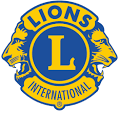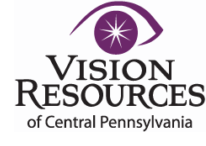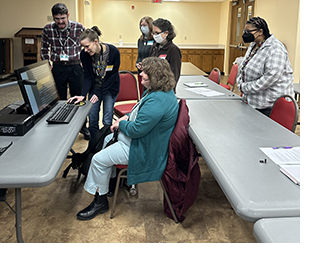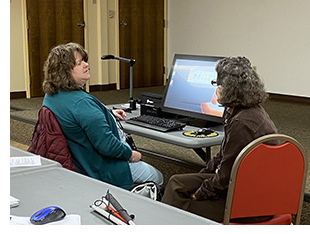 Through a happy confluence of local and statewide organizations devoted to tearing down barriers, The Library now has state-of-the-art technology offering visually impaired or blind residents access to the printed word and other library materials. Vision Resources of Central Pennsylvania, Dauphin County Library System, and three Lions Clubs – and their state organization will come together on Monday, April 24 at 10:00 a.m. along with the Dauphin County Commissioners Mike Pries and George Hartwick to celebrate the National Library Week theme “There’s More to the Story” by unveiling the new equipment. Following a media announcement, the commissioners will read theme-fitting books to an all-ages storytime crowd and Vision Resources and library staff will offer demonstrations of the equipment.
Through a happy confluence of local and statewide organizations devoted to tearing down barriers, The Library now has state-of-the-art technology offering visually impaired or blind residents access to the printed word and other library materials. Vision Resources of Central Pennsylvania, Dauphin County Library System, and three Lions Clubs – and their state organization will come together on Monday, April 24 at 10:00 a.m. along with the Dauphin County Commissioners Mike Pries and George Hartwick to celebrate the National Library Week theme “There’s More to the Story” by unveiling the new equipment. Following a media announcement, the commissioners will read theme-fitting books to an all-ages storytime crowd and Vision Resources and library staff will offer demonstrations of the equipment.
 “There’s a digital divide, and that digital divide is even wider for people with disabilities,” said Londa Peterson, Access Technology Specialist for Vision Resources of Central Pennsylvania. “Vision is the one that’s most left out. Vision is what we know, so that’s what we did.”
“There’s a digital divide, and that digital divide is even wider for people with disabilities,” said Londa Peterson, Access Technology Specialist for Vision Resources of Central Pennsylvania. “Vision is the one that’s most left out. Vision is what we know, so that’s what we did.”
The equipment, housed at East Shore Area Library, constitutes a computer and a software program called Fusion, which combines two venerable programs into one package — the visual enhancement capabilities of ZoomText and the screen reading functionality of JAWS.
“The Library is for everyone, including those with barriers to reading through blindness and visual impairments,” said Dauphin County Library System Executive Director Karen Cullings. “We are grateful to the Lions Club for partnering with us. This equipment opens a new door to reading for thousands of Dauphin County residents.’’
Working toward a goal
 The story begins with a Library staffer so impressed when The Library gave a presentation to the Lower Paxton Township Lions Club that she joined the club. The Lions are known worldwide for supporting the visually impaired and people who are blind, and the staffer informed the club that The Library’s vision-assistance equipment at East Shore Area Library was outdated – so antiquated that few staff knew how to operate it.
The story begins with a Library staffer so impressed when The Library gave a presentation to the Lower Paxton Township Lions Club that she joined the club. The Lions are known worldwide for supporting the visually impaired and people who are blind, and the staffer informed the club that The Library’s vision-assistance equipment at East Shore Area Library was outdated – so antiquated that few staff knew how to operate it.
Club Treasurer Richard Krieger did some research and learned that 6,000 residents of Lower Paxton Township, home to East Shore Area Library, are visually impaired or blind, and another 2,000 have reading impairments.
Before long, the Lower Paxton Lions teamed with the Lower Paxton Township Lioness Lions Club and West Hanover Lions Club to raise funds for new equipment. Then the Lions of Pennsylvania Foundation matched their contribution with a grant.
The effort raised $3,700 – enough to completely cover the equipment’s cost.
“There was a need,” said Krieger. “We put our heads together and our resources. Hopefully, it’ll be well used.”
 The Library contracted with Vision Resources of Central Pennsylvania (VROCP, formerly Tri-County Association for the Blind) to provide initial and ongoing training. VROCP has helped train Library staff on vision equipment in the past, but the new system is “a little easier to maneuver without too much training,” said Executive Director Danette Blank.
The Library contracted with Vision Resources of Central Pennsylvania (VROCP, formerly Tri-County Association for the Blind) to provide initial and ongoing training. VROCP has helped train Library staff on vision equipment in the past, but the new system is “a little easier to maneuver without too much training,” said Executive Director Danette Blank.
The equipment’s placement in The Library could raise awareness of available technology among people who are losing sight or have family members needing help.
“We just want to make sure that people are educated and aware that with things like this, your life isn’t over,” said Blank. “You don’t have to sit at home and listen to the TV. You can read your books. It’s important for all nonprofits to partner because we can help each other in this day and age when there are limited funds and limited people.”
Capabilities
The Library has six staff members trained on the equipment, plus the ability to bring back Vision Resources to train any new personnel
“Now that we have a relationship with them, we have a much better support system to make sure we’re keeping this computer and the software updated, as well as having someone who knows extremely well how to use this equipment and use them as a resource,” said Lori Milach, The Library’s Public Services Director.
What does the system do?
“Everything!” Milach said. “I cannot tell you how much fun we had learning about this technology. It was eye-opening.”
Like the old system, the new system magnifies printed material, such as a book or newspaper. It also performs text to speech, whether it’s voicing a letter, an email, or a Facebook page. It can even, in conjunction with the voice capabilities, scan printed material.
“It’s so versatile,” said Milach.
Krieger calls it “a top-notch, top-of-the-line instrument.”
“It has the verbal capability and also magnification capability,” he said. “It offers ease of use and a huge screen, so it could be doing a lot of things.”
The training not only equips staff to use the equipment but teaches them to understand and empathize with the challenges faced by people with vision impairments, Milach said.
Londa Peterson, the Vision Resources technology specialist who trained staff, has never seen Library personnel so enthused and amazed by an enhancement system.
“I really tried to provide them with the materials and training they need to do more than just turn it on,” she said. “Now, they have the basic idea of how to use the equipment so they can actually guide someone who needs to use it.”
The system is located on the main floor of East Shore Area Library, through the door by the upper handicapped parking area and ramp. The system can be especially valuable for someone who lacks similar equipment at home. They can try it at The Library, and if they want to pursue it, Library staff can refer them to Vision Resources for further assistance.
“They don’t have to go to a special location,” Milach said. “We are now a location that can support everyone.”
Spreading the word
The community “needed something that could work for someone no matter what level of vision they have,” said Peterson. “A single solution – one package, and everything’s in it. We wanted to keep it simple and yet have something that could serve everyone. This serves everyone.”
The Library also holds a Braille collection, largely comprising fiction for young readers. Through The Library’s affiliation with LAMP, or Library of Accessible Media for Pennsylvanians, people with visual impairments can access audiobooks, braille material, large-print books, and other items that make reading accessible (www.mylamp.org).
The Library intends to spread the word about the acquisition to local intermediate units, retirement communities, and other organizations that support people with visual impairments or blindness.
“Part of our goal is to raise awareness for those in our community who are visually impaired, and let them that there are services the library can provide for them,” said Milach. “The Library really is for everyone.”



